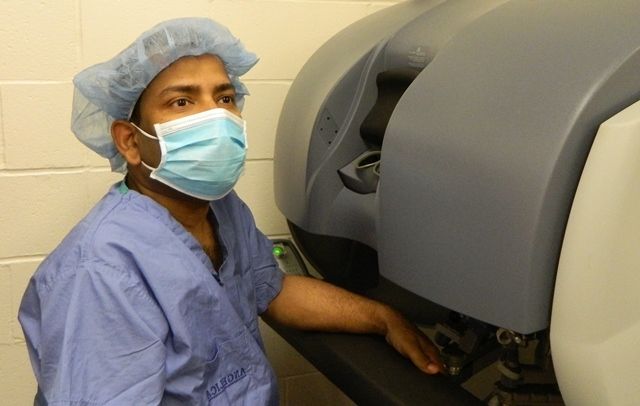Robotic surgery has become increasingly popular in recent years for a variety of procedures, including thoracic and abdominal surgeries. While robotic surgery may offer some advantages over traditional surgical techniques, such as increased precision and less scarring, there are also several limitations and potential risks associated with the technology. In this essay, we will explore some of the advantages and disadvantages of robotic surgery for thoracic and abdominal procedures, and discuss some of the factors that must be considered when deciding whether to use this technology.
One of the primary advantages of robotic surgery for thoracic and abdominal procedures is increased precision. Robotic surgical systems are equipped with advanced imaging technologies and surgical instruments that allow surgeons to perform highly precise movements with a high degree of accuracy. This can be particularly important for procedures that require delicate and precise movements, such as surgeries on the lungs, heart, or other vital organs.
Another advantage of robotic surgery is that it can be performed with smaller incisions than traditional open surgery, which can reduce scarring and improve recovery times. This is because robotic surgical instruments are designed to be inserted through small incisions, which can reduce the amount of tissue that needs to be cut and manipulated during the procedure.
Additionally, robotic surgery may provide some advantages in terms of the surgeon's comfort and ergonomics. Robotic surgical systems are designed to be operated from a console, which allows the surgeon to sit comfortably and maintain a neutral posture during the procedure. This can reduce the risk of musculoskeletal injuries and fatigue, which can be common among surgeons who perform open surgeries.
However, there are also several limitations and potential risks associated with robotic surgery for thoracic and abdominal procedures. One potential limitation is the cost of the technology, which can be significantly higher than traditional surgical techniques. This can make robotic surgery inaccessible for some patients, particularly those who do not have insurance coverage or who live in regions without access to advanced medical technologies.
Another potential limitation of robotic surgery is the learning curve associated with the technology. Robotic surgery requires a high level of skill and expertise on the part of the surgeon, and it can take several procedures for a surgeon to become proficient with the technology. This can increase the risk of complications and adverse outcomes for patients who undergo robotic surgery with inexperienced surgeons.
Additionally, there are some potential risks associated with robotic surgery that may not be present with traditional surgical techniques. For example, robotic surgical instruments are controlled by a computer system, which can malfunction or fail during the procedure. This can result in unintended movements of the surgical instruments or other complications that can increase the risk of injury or other adverse outcomes for the patient.
Despite these limitations and potential risks, robotic surgery for thoracic and abdominal procedures may still provide some advantages over traditional surgical techniques. However, it is important to carefully consider the individual patient's needs and circumstances when deciding whether to use this technology.
For example, some patients may not be good candidates for robotic surgery due to underlying medical conditions or other factors that increase the risk of complications. Additionally, patients who require emergency surgery or who have advanced or complex conditions may be better served by traditional open surgery, which can provide the surgeon with a greater degree of control and flexibility during the procedure.
Additionally, it is important to note that robotic surgery is not appropriate for all types of thoracic and abdominal procedures. For example, some surgeries may require a greater degree of tactile feedback and control than can be provided by a robotic surgical system. Additionally, some types of procedures may be better suited to traditional open surgery, which can provide the surgeon with a greater degree of flexibility and control during the procedure.
Another potential limitation of robotic surgery for thoracic and abdominal procedures is the longer operating time. Because robotic surgery requires a higher level of precision and control, the operating time for these procedures may be longer than for traditional open surgery. This can increase the risk of complications such as bleeding, infection, and other adverse outcomes, particularly for patients who are already at higher risk for complications.
Despite these limitations and potential risks, robotic surgery for thoracic and abdominal procedures has become increasingly popular in recent years, particularly in high-volume surgical centers and academic medical centers. This is due in part to the potential advantages of the technology, such as increased precision and smaller incisions, as well as the growing availability of robotic surgical systems and training programs for surgeons.
However, it is important to note that the long-term benefits and risks of robotic surgery for thoracic and abdominal procedures are still not fully understood. While some studies have suggested that robotic surgery may provide advantages over traditional surgical techniques, others have found no significant difference in outcomes between the two techniques.
Additionally, there is a need for continued research and development in robotic surgery for thoracic and abdominal procedures. This includes the development of new surgical instruments and imaging technologies, as well as the refinement of existing techniques to improve the safety and effectiveness of the procedure.
In conclusion, robotic surgery for thoracic and abdominal procedures provides some advantages over traditional surgical techniques, such as increased precision and smaller incisions. However, there are also several limitations and potential risks associated with the technology, including cost, the learning curve associated with the technology, and the longer operating time. Ultimately, the decision to use robotic surgery for thoracic and abdominal procedures must be based on a careful consideration of the individual patient's needs and circumstances, as well as the surgeon's expertise and experience with the technology. As research and development in robotic surgery continue, it is likely that we will see further advances in the safety and effectiveness of the procedure, which will ultimately benefit patients by reducing pain, improving outcomes, and reducing the cost of healthcare.
